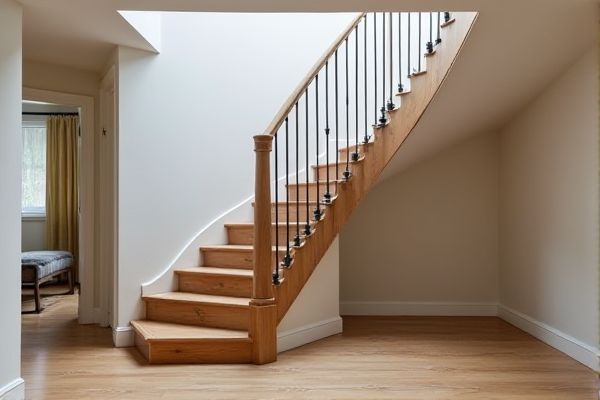
Engineered stairs offer precision and faster installation with pre-manufactured components, ensuring consistent quality and durability compared to traditional site-built stairs, which provide customization tailored to your specific space but require more time and skilled labor. Explore the rest of the article to understand which stair solution best fits your home improvement needs.
Table of Comparison
| Feature | Engineered Stairs | Site-Built Stairs |
|---|---|---|
| Construction | Prefabricated in factory | Built on-site |
| Installation Time | Quick, less than a day | Longer, several days |
| Cost | Typically lower | Usually higher |
| Customization | Limited to design options | Highly customizable |
| Quality Control | Controlled factory environment | Variable, depends on site conditions |
| Material Waste | Minimized due to factory precision | More waste generated on-site |
| Durability | Consistent and tested standards | Varies based on craftsmanship |
| Design Complexity | Better for standard designs | Suitable for complex, custom designs |
Introduction to Engineered vs Site-Built Stairs
Engineered stairs are pre-manufactured components designed for quick installation and consistent quality, ideal for projects needing precision and efficiency. Site-built stairs are custom constructed on-location, offering maximum flexibility to match unique architectural details and space constraints. Your choice depends on balancing the need for speed and uniformity against the desire for tailored craftsmanship in stair design.
Key Differences Between Engineered and Site-Built Stairs
Engineered stairs are pre-manufactured using precise measurements and standardized materials, offering consistent quality and faster installation compared to site-built stairs, which are custom-crafted on-site from raw materials to fit unique spaces. Engineered stairs typically feature modular components and are designed for durability and ease of assembly, while site-built stairs provide greater flexibility in design but require skilled labor and longer construction time. The cost efficiency and time savings of engineered stairs contrast with the bespoke nature and potentially higher customization of site-built stairs.
Material Options for Engineered and Site-Built Stairs
Engineered stairs typically use prefabricated components made from materials like laminated wood, metal, and engineered composites, offering consistent quality and faster installation. Site-built stairs provide greater flexibility with traditional materials, including solid hardwoods, natural stone, and custom metalwork, allowing for unique design and precise fitting to irregular spaces. Material choice directly impacts durability, aesthetics, and cost, with engineered stairs favoring efficiency and site-built stairs prioritizing customization.
Design Flexibility and Customization
Engineered stairs offer limited design flexibility due to pre-fabricated components and standardized dimensions, which can restrict customization options in complex layouts or unique architectural styles. Site-built stairs provide unparalleled customization, allowing intricate designs, varied materials, and precise fitting tailored to your specific space and aesthetic preferences. Choosing site-built stairs ensures your staircase seamlessly integrates with your home's unique design requirements, enhancing both form and function.
Installation Process Comparison
Engineered stairs offer a streamlined installation process, typically arriving pre-fabricated and ready for quick assembly, reducing on-site labor time and minimizing errors. Site-built stairs require precise measurements, cutting, and fitting directly at the construction site, often leading to longer installation times and higher labor costs. The prefabrication of engineered stairs ensures consistency and faster project completion compared to the customization and adjustments needed for site-built stairs.
Durability and Structural Integrity
Engineered stairs offer superior durability due to factory-controlled manufacturing processes that ensure consistent material quality and precise assembly, minimizing defects and weaknesses. Site-built stairs rely heavily on on-site craftsmanship, which can lead to variability in structural integrity depending on installer skill and environmental conditions. Engineered stair components often incorporate advanced materials like laminated wood or metal reinforcements, enhancing load-bearing capacity and long-term stability compared to traditional wood construction methods used in site-built stairs.
Cost Analysis: Engineered vs Site-Built Stairs
Engineered stairs typically offer a more cost-effective solution compared to site-built stairs due to standardized manufacturing processes that reduce labor expenses and minimize material waste. While site-built stairs allow for customized designs tailored to unique architectural features, they often incur higher costs from extended construction time and skilled labor requirements. You can optimize your budget by selecting engineered stairs for projects prioritizing efficiency and predictable pricing without sacrificing quality.
Maintenance and Longevity
Engineered stairs typically feature pre-finished materials and precision assembly, resulting in easier maintenance and enhanced durability compared to site-built stairs, which may require more frequent repairs due to variability in craftsmanship. The use of high-quality, factory-controlled components in engineered stairs contributes to their resistance against wear, warping, and settling over time. Site-built stairs, while customizable, often face challenges with structural integrity and material degradation, impacting their long-term longevity and upkeep requirements.
Safety Considerations and Building Codes
Engineered stairs offer precise manufacturing tolerance, ensuring consistent rise and run dimensions that enhance safety and comply with international building codes like the IBC and IRC. Site-built stairs may vary in quality depending on craftsmanship, potentially leading to irregular risers or treads that increase fall risks and fail inspections. Adhering to local safety regulations, engineered stairs reduce errors and provide reliable structural integrity, critical for residential and commercial applications.
Choosing the Right Stairs for Your Project
Engineered stairs offer precision, durability, and faster installation due to factory fabrication, making them ideal for projects with tight timelines and consistent quality requirements. Site-built stairs provide customization and adaptability, allowing builders to tailor designs to unique spaces and complex layouts. Selecting the right stairs depends on balancing budget, project scope, design complexity, and installation preferences to ensure optimal structural integrity and aesthetic appeal.
 homyna.com
homyna.com